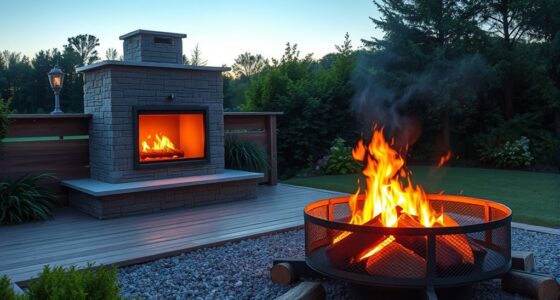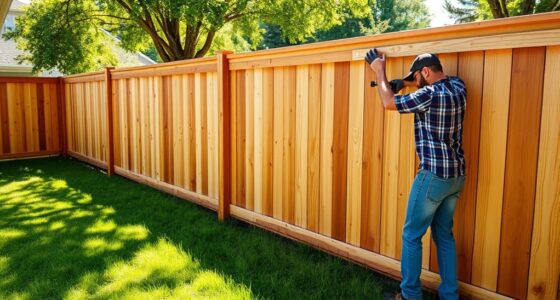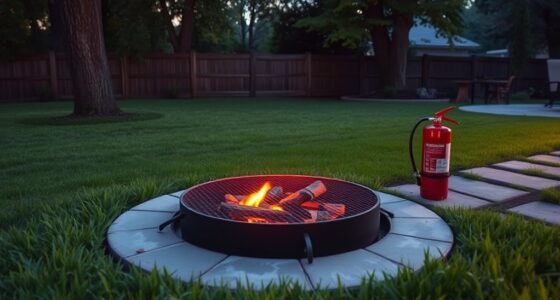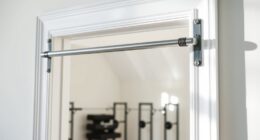If you want a structure that offers full weather protection and a private retreat, a gazebo might be right for you. It provides solid roofing, walls, and year-round comfort, ideal for entertaining or relaxing regardless of the weather. On the other hand, if you prefer a stylish, open-air space with partial shade and room for plants, a pergola suits your needs. To find the best fit for your outdoor area, consider what features and atmosphere matter most—more details await.
Key Takeaways
- Choose a gazebo for year-round weather protection and a private, enclosed space; opt for a pergola for open-air, customizable shading.
- Consider a gazebo if you need a durable, fully covered structure; select a pergola for a lighter, more decorative garden feature.
- Budget and construction time favor pergolas for simpler, less costly designs; gazebos generally require more investment and longer build time.
- For supporting climbing plants and enhancing landscape aesthetics, a pergola is ideal; for enclosed comfort and shelter, a gazebo is better.
- Match your style: traditional and cozy with a gazebo; modern and airy with a pergola.
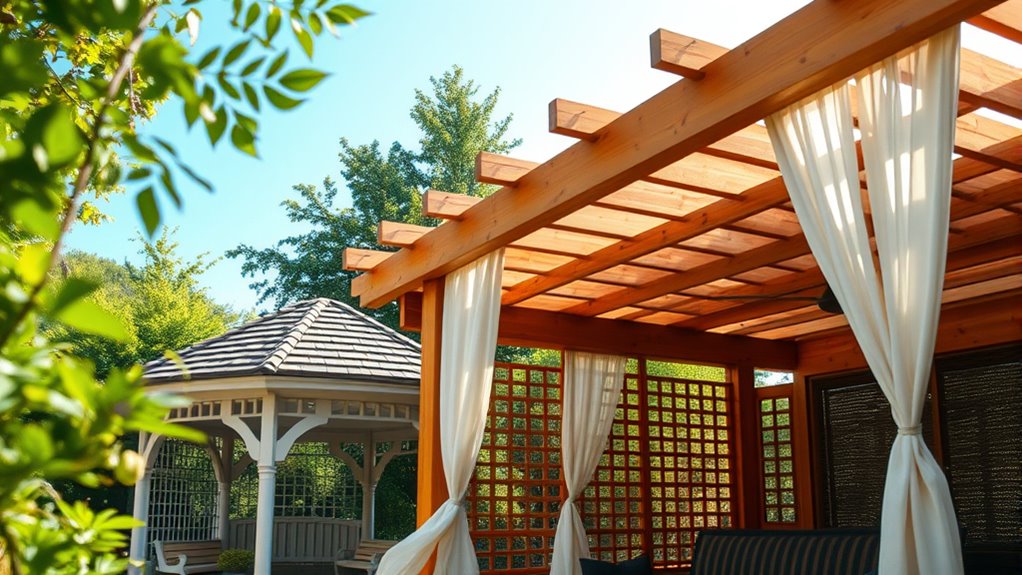
Are you trying to decide between a pergola and a gazebo for your outdoor space? Understanding their structural differences can help you choose the best fit for your needs. Gazebos are fully roofed structures, often with solid, permanent coverings that provide complete shade and weather protection. Their enclosed design, typically with four solid sides or screened panels, boosts privacy and shields you from rain, snow, and insects. Gazebs are built with sturdy materials like timber or metal to guarantee durability and often include flooring, turning them into versatile outdoor rooms. They’re ideal if you want a sheltered space for year-round use, entertaining, cooking, or relaxing regardless of the weather. Electrical wiring is more easily integrated into gazebos because of their enclosed design, making it simple to add lighting or appliances. Additionally, their solid construction often allows for better insulation, enhancing comfort in different seasons.
In contrast, pergolas feature open roofs made of spaced beams, with options for louvered or retractable canopies. This design allows partial or adjustable shade, making pergolas more suitable for mild weather and sunlit gatherings. They’re sleeker, less cluttered, and can be built from a variety of materials like wood, aluminum, or vinyl, which generally makes them more affordable and quicker to construct. Pergolas can stand alone or attach to a building, blending seamlessly into garden landscapes. Their open structure is perfect for supporting climbing plants, vines, and flowers, enhancing the aesthetic appeal of your yard. However, because they lack solid roofing or walls, pergolas don’t offer full weather protection, so you’ll mainly use them for casual outdoor dining or relaxing in fair weather. Maintenance needs vary depending on the material used, with wood requiring regular sealing and metal needing rust prevention. Their open design also encourages airflow, which can help keep the space cooler during hot days.
When it comes to cost and construction, pergolas usually cost less and take less time to build due to their simpler design. They typically don’t require flooring or extensive roofing, which keeps expenses down. Gazebos, with their more complex framework, roofing, and optional flooring, tend to be pricier and demand more substantial materials and labor. Both structures can elevate your yard’s visual appeal and value, but they create different atmospheres. Pergolas add a modern, elegant touch with their open, airy feel, suitable for blending into garden spaces. Gazebos offer a traditional, pavilion-like appearance, serving as a focal point or private retreat.
Ultimately, your choice depends on your specific needs for weather protection, functionality, and aesthetic preferences. If you want a sheltered, versatile space for all seasons and activities, a gazebo might be the better option. If you prefer a stylish, open-air feature primarily for mild weather gatherings and landscaping, a pergola could be ideal. Considering outdoor structure benefits can help you make a more informed decision suited to your lifestyle and outdoor environment.
Frequently Asked Questions
Which Option Is More Cost-Effective for Small Yards?
You’re looking for the most cost-effective option for your small yard, and pergolas often fit that need best. They cost less upfront, thanks to simpler designs and easier installation, making them budget-friendly. Plus, their smaller size and open structure help maximize limited space without crowding. While maintenance might be higher, their affordability and flexibility usually make pergolas a smarter choice for small yards seeking value and functionality.
Can Pergolas and Gazebos Be Customized Architecturally?
Did you know that over 75% of homeowners customize their outdoor structures? You can definitely tailor pergolas and gazebos architecturally. Pergolas offer extensive options like beam styles, column designs, and personalized dimensions, while gazebos let you choose roof styles, shapes, and finishes. Both structures support functional features like lighting or screens. With these customization options, you can create a unique outdoor space that perfectly matches your style and needs.
Are There Maintenance Differences Between Pergolas and Gazebos?
You’ll notice that pergolas usually need less maintenance because they have open designs and fewer surfaces to upkeep. Wood pergolas require staining or sealing every 1–2 years, while metal or vinyl options need minimal care, mostly cleaning. Gazebos demand more attention, like roof inspections, screen repairs, and railing upkeep, especially if made of wood. Regular maintenance helps extend their lifespan, but overall, pergolas tend to be easier to care for.
Which Provides Better Protection From Weather Elements?
Imagine standing under a sturdy shelter, feeling the rain bounce off a solid roof, or the sun’s rays filtering softly through slats. You’ll find gazebos provide better protection from weather elements with their fully enclosed roofs, shielding you from rain, snow, and harsh sun. Pergolas, with open or slatted roofs, offer partial protection and are ideal for sun control but aren’t as reliable against rain or snow unless upgraded with special features.
How Do Structural Requirements Differ for Installation?
You need to understand that structural requirements vary based on your chosen structure. For gazebos, you’ll need a sturdy foundation like a concrete slab or post holes, often requiring permits and possibly a structural engineer’s help. Pergolas are generally simpler to install, especially when attached to your home or existing structures, and may not need a complex foundation. Material choice and installation complexity also influence the process.
Conclusion
Now that you know the differences, it’s clear that choosing between a pergola and a gazebo can transform your outdoor space into a personal paradise. Whether you want the sleek elegance of a pergola or the cozy charm of a gazebo, the right choice will elevate your backyard to legendary status. Don’t settle for an ordinary backyard—your space deserves to be an awe-inspiring oasis where memories are made. Pick the perfect structure and watch your outdoor dreams come true!



